Acquiring, Owning, and Training with a Defensive Firearm
A framework is a structural plan for a project. I find that, when training new defensive shooters, common questions are “What type of firearm should I purchase?” “How should I train?” and “How should I continue to develop my skills?” I hope to give some insight on how to answer those questions and give further steps to take after you attend a proper training course.
A common scenario is that a person decides to buy a firearm for self-defense. They do some type of research, which most commonly is to ask a friend who has a lot of guns, look in the latest magazines, or search on the internet. They find the gun they believe will do the job, take a handgun safety course, and hit the indoor range to “practice.” I see this happen far too often.
There are many holes in this process. They might take a basic pistol course, but this does not give them a complete framework for developing the necessary skills to protect themselves or their loved ones. It is important to note that in 2011 there was a significant rise in handgun purchases, but that rise did not significantly increase the amount of students in defensive shooting courses. As a defensive firearms training instructor, I find this disturbing because I believe an untrained handgun owner is just as dangerous as those whom we are protecting ourselves from.
The process I recommend helps the new gun owner develop a framework for how they intend to train with their defensive firearm and employ it efficiently if necessary to defend themselves. Just like the process it takes to build a home or skyscraper, the same principles can be applied to purchasing a firearm for self-defense, familiarizing yourself with its operation, receiving proper training, developing your competency, and lastly gaining further exposure off the range.
Unique Factors of Owning a Defensive Firearm
Purchasing your first firearm for self-defense should not be based on impulse or excitement. There are a few factors to take into account prior to even choosing the right firearm for you. Factors include legal, home situation, internal social acceptance, storage, and employment rules. By taking the time to address these factors, you can begin to develop your framework.
Legal Factors
Considering the legal factors of firearm ownership should be your first step. Though local, state, and federal firearms laws may be confusing and cumbersome, you are held accountable for adhering to them. Just because they are confusing doesn’t mean you are exempt from following them. Check out the laws on which types of firearms you are allowed to have, which self-defense laws apply to you, and which laws apply to possessing a firearm in public.
A good place to start reading up on legalities is right here on PDN, where we have several articles on the legal ramifications of shooting someone.
Home Situation
How does your partner feel about having a firearm in the home? If you have children, what controls are you going to put in place to prevent them from acquiring the firearm? These are personal decisions you have to make and should make prior to purchasing a firearm, especially if the firearm is meant for self-defense. A defensive firearm does you no good if you can’t access it when and where you need it.
Internal Social Acceptance
This is a follow-on factor from that previously mentioned. It is important to find out how others in your home feel about firearms. I have found that educating them on firearms (safety, operation, and responsibility) is the best way to tackle this. I recommend to my clients that they attend a training course with their partner to assist in possibly getting them comfortable with owning a firearm. There are some people who, no matter what, want nothing to do with firearms. It is good to know this up front to avoid internal conflicts later on.
Storage
Firearms storage should be planned, and there are many options on the market for it. Whether you choose a large safe or a quick-acting safe, understand the big picture. The purpose of firearms storage is to provide a safe area to keep your firearm to prevent an unauthorized person from accessing it. Another consideration with storage is where in your home or business you store the firearm so you can get to it when you need it.
Employment Rules
Under what circumstances are you willing to deploy your firearm in self-defense? I believe this is the most important factor to deal with. Having a firearm doesn’t make you safer, but how you use the firearm does. There are many opinions on when you should use your firearm — and if you do, there are consequences. You as the owner have to decide when to employ your firearm and understand that you will be held accountable for your actions. I mention this not to scare you from owning a firearm for self-defense, but to help you understand the responsibility.
This also relates back to the first factor, legal considerations. Do you know what “justifiable use of deadly force” means where you live? Understand that now, before you might need to use it. Do what you feel is right, be able to justify why, and stand by your decision in the aftermath.
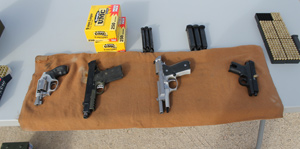
Choosing the right firearm for personal protection can be a complicated task. Exposure to various firearms can assist in making a sound decision.
Purchasing a Defensive Firearm
Once you have addressed these factors, it’s time to research and purchase a firearm. I recommend you consider the following factors: fit, availability, caliber, legality, and efficiency.
Fit
Does the firearm fit your hand properly? If you intend on carrying the weapon concealed, will it fit in with your clothing?Availability
Is the firearm available for purchase in your area? This goes along with the legal factors. Don’t get caught with an illegal firearm!
Caliber
Choose a caliber that you can handle efficiently. If a partner may be using your firearm, make sure they can handle the caliber too. I recommend a good defensive 9mm (Bonded hollow point) due to its cost-effectiveness and recoil management.
Efficiency
A defensive firearm should be able to be employed with the least amount of time, effort and energy. I recommend modern striker-fired firearms (e.g., Glock, Smith & Wesson M&P, or Springfield XD) for defensive use because of their simplicity and reliability. A defensive firearm needs to be one that can be employed at a moment’s notice. However, if these firearms don’t meet your total criteria (i.e., fit), find one that is most efficient for you.
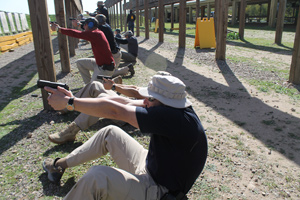
Training to shoot in positions other than standing enhances your training and translates well to a realistic environment.
Familiarizing Yourself with the Firearm and Proper Training
Get familiar with your firearm by finding a safe area where you can disassemble, clean, and administratively handle it. More importantly, get to a training course with a competent instructor who has knowledge of your firearm. I am a huge supporter of gun owners taking courses to get proper guidance on how to work with firearms.
I recommend that new shooters in all genres (recreation, hunting, competition, etc) take training courses. How many you take will be based on your budget, time, and resources. The most important training you can take is the one that fits your context. I don’t recommend a person wanting to learn defensive shooting to take a course on IDPA shooting. If you are using your handgun for self-defense, take a defensive shooting course. On the other hand, if you want experience in competition shooting, take a course for competitive shooters.
In order to develop your competency after your training course, sit down and develop a plan for personal training. For example, you could take two or three days a month to work on your competency. A good method is to learn a new skill, practice that skill and, once you feel competent, learn a new skill, practice the new skill, review the previous skill, and continue to build. My mentor Rob Pincus calls it “front loading” your training.
Off the range, you can still get exposure to defensive shooting by reading, watching, and conversing on the subject. Reading magazines, watching DVDs, and talking with peers and instructors are great ways to further develop your competency. The articles and videos here on the Personal Defense Network will help you learn new skills or reframe your previous training model. Watching a DVD on defensive shooting may give you drills to improve your application of skill on the range or in a defensive situation. Before you make a modification, test it on the range safely and get some feedback from a defensive shooting instructor.
Summary
I have given you a basic framework or structure on which to build your plans to acquire, train, and employ your defensive firearm skills. Dealing with the factors, choosing the right defensive firearm, and developing your competency are the keys to building a proper strategy for personal defense with a firearm.
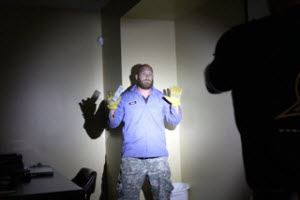

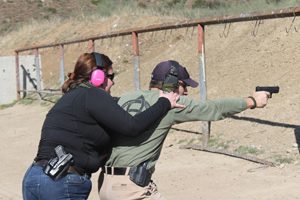
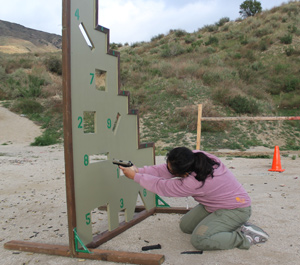
Great introductory article. Many people don't stop to think about these questions. Living in NJ, I tell people if anything goes you may go to jail... it's a big responsibility to own a firearm. Even if all you do is keep it locked up, it still needs maintenance...
You have made some decent points there. I looked on the web to find out more about the issue and found most people will go along with your views on this web site.